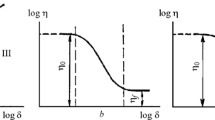Abstract
A large number of publications addressing the solidification of glass in molding has been systematized. Different aspects of the effect of the basic composition of glass, diathermancy, time and structural factors on solidification processes are discussed. The workability of glasses and the main conditions for mechanized formation of glass articles are considered as well.
Similar content being viewed by others
REFERENCES
W. Gigerich and W. Trier, Glass-Forming Machines [Russian translation], Mashinostroenie, Moscow (1968).
M. A. Bezborodov, Viscosity of Silicate Glasses [in Russian], Nauka i Tekhnika, Minsk (1975).
V. P. Klyuev and A. S. Totesh, Methods and Instruments for Glass Viscosity Control [in Russian], VNIIÉSM, Moscow (1975).
Yu. A. Guloyan, Working Properties of Glasses and Conditions for Mechanized Formation of Glass Articles [in Russian], VNIIÉSM, Moscow (1975).
K. T. Bondarev, Polished Glass [in Russian], Stroiizdat, Moscow (1978).
V. P. Khramkov, Yu. A. Guloyan, and V. I. Laptev, Formation of Glass Articles [in Russian], Legkaya Industriya, Moscow (1980).
M. Coenen, “Durchstrahlung des Glasbades Bei farblasern,” Glastechn. Ber., 41(1), 1–10 (1961).
G. A. Digilina, “The effect of temperature on glass absorption in the short-range IR spectrum,” in: Production and research of glass and silicate materials, Issue 9 [in Russian], Moscow (1988), pp. 116–122.
Yu. A. Guloyan, “Diathermancy and kinetic factors of glass solidification,” Izv. Akad. Nauk SSSR, Ser. Neorg. Mater., IX(11), 2045–2046 (1973).
Yu. A. Guloyan and K. S. Katkova, “Estimate of light-shielding and technological properties of tinted container glasses,” Steklo Keram., No. 7, 10–12 (1974).
A. B. Atkarskaya and V. I. Kiyan, “Reasons for glass melt diathermancy variation in an operating tank furnace,” Steklo Keram., No. 10, 8–10 (2001).
L. D. Konovalova and L. F. Yurkov, “Some thermophysical properties of container glasses,” Steklyannaya Tara, No. 9, 8–9; No. 10, 6–7 (2004).
E. G. Frolova, Study of Solidification of Glass Melt in Vertical Drawing, Author’s Abstract of Candidate’s Thesis [in Russian], Moscow (1951).
M. V. Okhotin and Yu. A. Guloyan, “A study of the process of glass solidification in the formation interval,” Steklo Keram., No. 6, 13–15 (1969).
C. Babcock and D. McGrow, “Application of glass properties data to forming operation,” Glass Ind., 38(3), 137–161 (1958).
W. Trier, “Temperature distribution and heat flow in glass in blank molds of container machines,” J. Am. Ceram. Soc., 44(7), 207–211 (1961).
G. V. Ermakov and V. V. Kupfer, “The problem of cooling and solidification of glass,” Steklo Keram., No. 7, 8–10 (1978).
I. V. Borovikov, “Structure of glass,” Dokl. Akad. Nauk SSSR, 76(6), 867–869 (1951).
S. I. Sil’vestrovich, N. M. Pavlushkin, V. S. Koshel’kova, and N. Yu. Mikhailenko, “The surface structure of industrial glass products,” Steklo Keram., No. 12, 12–16 (1970).
A. Lyle, “Working characteristics of glasses,” Glass Ind., 48(5), 36–39 (1967).
B. E. Romanov, I. N. Gorina, G. M. Postnikova, and V. M. Budov, “Working characteristics of rolled glass,” Steklo Keram., No. 1, 16–17 (1973).
T. D. Andryukhina, E. I. Raevskaya, É. I. Sanina, and I. L. Tarasova, “Working characteristics of industrial sheet glasses,” Steklo Keram., No. 10, 4–7 (1976).
T. D. Andryukhina, E. I. Raevskaya, É. I. Sanina, and I. L. Tarasova, “Working properties of container glasses depending on their compositions,” Steklo Keram., No. 1, 5–6 (1980).
I. E. Ginsburg, L. D. Konovalova, and L. F. Yurkov, “Evolution of container glass compositions,” Steklyannaya Tara, No. 4, 1, 6–7; No. 5, 6–7; No. 6, 6–7 (1999); No. 1, 6–7, No. 2, 6–8 (2000).
N. F. Zhernovaya, V. I. Onishchuk, V. A. Kurnikov, and F. E. Zhernovoi, “Operating estimate of working parameters of container glasses,” Steklo Keram., No. 10, 3–5 (2001).
A. V. Gorshkov, “The estimate of the relative operating speed of the glass-forming machine,” Steklyannaya Tara, No. 11, 4–5 (2002).
Yu. A. Guloyan, “The estimate of some factors in formation of glass articles,” Steklo Keram., No. 6, 18–20 (1989).
J. Pool, “Glass workability,” Glass Ind., 47(3), 178–181 (1968).
K. I. Braginskii, “On the theory of glass formation,” Steklo Keram., No. 5, 16–18 (1967).
Yu. A. Guloyan, Technology of Glass and Glass Products [in Russian], Transit-Kh, Vladimir (2003).
Author information
Authors and Affiliations
Additional information
Translated from Steklo i Keramika, No. 11, pp. 3 – 7, November, 2004.
Rights and permissions
About this article
Cite this article
Guloyan, Y.A. Solidification of glass in molding (a review). Glass Ceram 61, 357–361 (2004). https://doi.org/10.1007/s10717-005-0001-9
Issue Date:
DOI: https://doi.org/10.1007/s10717-005-0001-9




